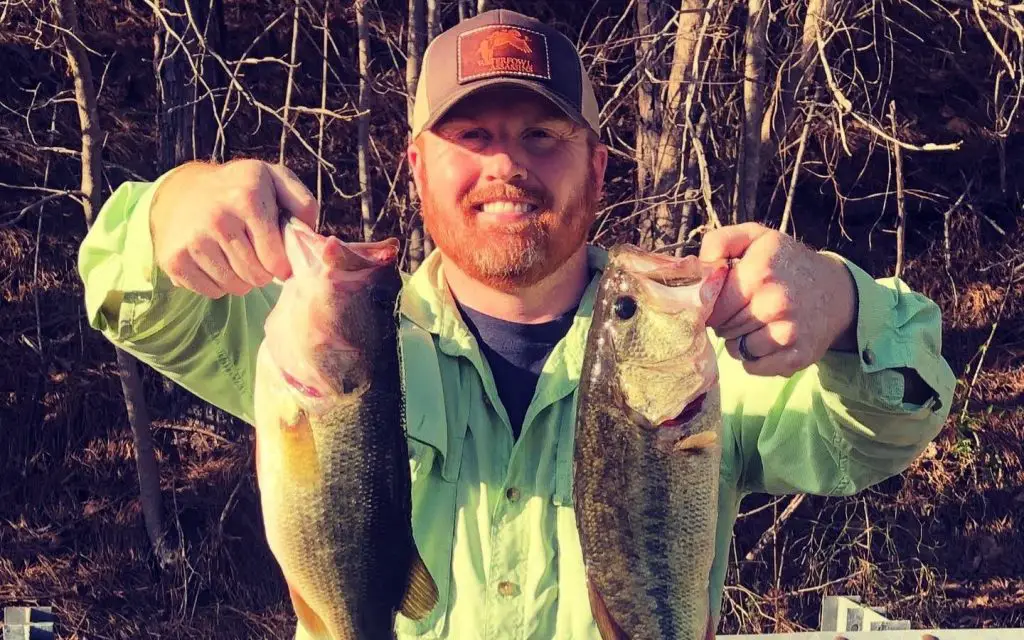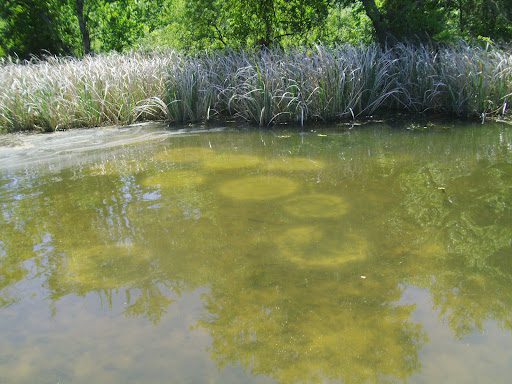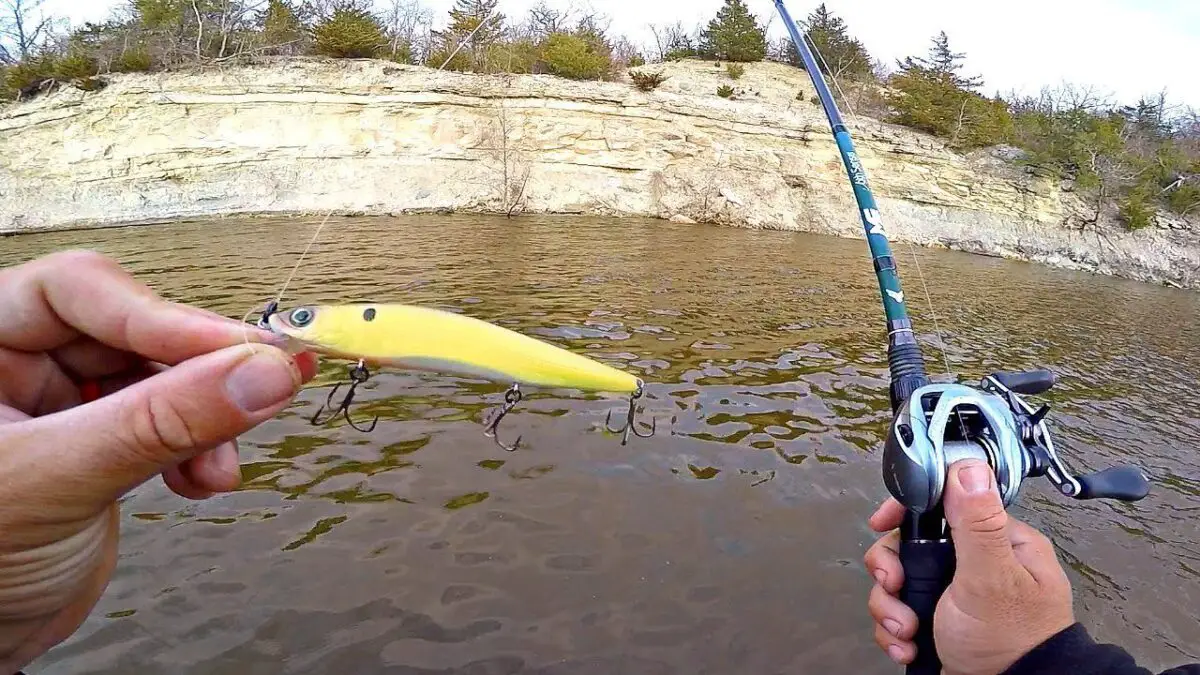To catch bedding bass, locate spawning areas in shallow waters with a clear view of the beds. Use stealth to avoid spooking fish, cast subtle and natural-looking soft plastic baits or creature baits near the bed, and employ a slow, patient retrieve with gentle, enticing movements to trigger a defensive strike.
The spawn is easily the most exciting time of the year for bass fishing anglers, like myself. The fish are usually feeding voraciously during the pre-spawn weeks when the water continually warms, but once they lay their eggs, you have a small window in which you can catch trophy-sized bass with relative ease.
Knowing how to catch bedding bass is a challenge if you aren’t sure which tactics and techniques to use. Keep reading to find out some of the tried-and-true methods I use, as well as the best tips on how to catch bedding bass.
This article is part of my Complete Guide to Bass Fishing series that you might be interested in.
| Technique/Lure | Situation | Effectiveness |
|---|---|---|
| Soft Plastic Creature Baits | Flipping and pitching onto beds | ⭐⭐⭐⭐⭐ |
| Texas-rigged Stick Worms | Bedding areas, slow and subtle presentations | ⭐⭐⭐⭐⭐ |
| Jigs with Craw Trailers | Slow dragging along the bottom of the bed | ⭐⭐⭐⭐ |
| Tube Baits | Mimicking crawfish or baitfish around beds | ⭐⭐⭐⭐⭐ |
| Drop Shot with Soft Plastics | Targeting suspended or finicky bedding bass | ⭐⭐⭐⭐ |
| Topwater Frogs | Over shallow beds or around cover | ⭐⭐⭐⭐ |
| Sight Fishing with Floating Worms | Clear water, high visibility bedding areas | ⭐⭐⭐⭐⭐ |
Table of Contents
Bedding Bass Behavior
Before I get into the best ways to catch bedding bass, it’s important to understand the behavior of the fish during this time and why they are more willing to bite in most cases. Catching bedding bass sometimes requires anglers to get creative with their approach and if you use the right tactics, you can catch the bass of a lifetime.
Bass will be feeding heavily during the pre-spawn, which usually takes place during the months of March or April across much of the United States. Once the water temperature climbs above the 45 or 50 degree mark, I expect bass to start moving out of their deep winter abodes into the shallow coves or rivers that feed into most lakes.
The methods I use to catch bass during the pre-spawn are vastly different from those that work on bedding bass. Once the water temperature gets up to about 55 to 65 degrees, bass will seek out the right spot to lay their eggs. These locations are often well-protected sites that are in the shallows where the water might be just a few feet deep.
Not all bass will spawn at the same time and I can attest to the fact that the larger female bass tend to spawn earlier than the rest. Once they begin the spawn, you’ll have a few short weeks to catch bedding bass.

How to Find Bedding Bass
If you’re going to catch bedding bass, I always resort to a method known as sight-fishing. This is basically where you cruise around the lake or walk around the edges of the shoreline looking for the distinct signs of a bass bed.
Bass beds will usually be within about 10 feet of the shoreline in areas where the water is more of a shallow flat instead of a steep drop-off. I look for areas where the sun is able to shine on the spot without shadows for most of the day since these will be the parts of the lake where the water heats up faster.
I have always noticed that the northern (south-facing) shorelines of any body of water will be a prime location for bedding bass. This is due to the fact that the sun hits these areas for longer periods throughout the day, meaning the water temps will be higher and more suitable for bedding bass.
Bass beds look like a dark spot in the water that’s in the shape of a circle or oval. They are usually about 18 inches in diameter and often near stumps, brush, or other cover in the water. Once I spot a bass bed, it’s best to keep your distance and watch closely to locate the bass. If I happen to come across a bed and spook the fish, back off for a while or mark the spot and come back later.

How to Catch Bedding Bass
You can usually get a sense of how large the bass is when it’s near the bed. The smaller males are usually a few feet away, patrolling the area for anything that might pose a danger to their eggs. The female will stay directly on top of or very close to the bed itself, watching over the eggs.
The female won’t be looking to eat anything while she’s on bed, so don’t think that you’re going to appeal to her appetite with your selection of lure. Rather, she will be looking to guard her eggs from any intruder that wants to eat them.
The most common creatures that pose a risk to fish eggs are usually other fish such as minnows, bluegill, perch, and even small bass. Other things like lizards, turtles, insects, and crawfish are also known to devour bass eggs when given the opportunity.
Your best chance of catching a bedded bass will be to mimic one of these predators and cause her to attack. There are a variety of methods I have used to do this.
Best Lures & Rigs for Bedding Bass
Regardless of the lure you choose to fish with, it’s best to use one that’s very bright as opposed to a natural color. The goal is to get the bass to notice your lure, not to resemble something that’s usually on her menu. Bass will see bright lures more easily than darker ones, so now is the time to use those weird pink, orange, or fluorescent green lures that have been sitting in your tackle box.
Here are my top 3 selections for the best lures for catching bedding bass.
1. Shaky Head
A shaky head is one of the best lures for bedded bass because it’s simple and easy to use. I like to cast the shaky head shortly past the bed and slowly bounce or drag it into the bed itself. If you’re lucky, the bass will immediately strike at the lure, but in most cases, you might have to be more persistent.
I’ve thrown the same lure into a bass bed for more than 30 minutes before getting a bite. If the bass is following your shaky head and isn’t ignoring it, be patient and keep trying until you get it to bite.

2. Tube Baits
Tubes are another ideal choice for bedding bass because they are also very simple, straightforward lures. I use a shorter lure than a longer one when fishing bass beds because the female usually bites the tail of whatever you’re throwing instead of devouring the whole bait. This is because bass are only looking to bite the intruder and relocate it away from their bed—not to eat it.
A tube bait is compact enough that the bass is more likely to get hooked compared to longer finesse worms. Tube baits resemble some of the usual suspects that bass expect to raid their bed and eat the eggs in it.
3. Plastic Lizard
If you’re fishing in a pond or smaller lake, a plastic lizard is often a reliable lure for catching bedding bass. I like to fish these with a Texas rig as it lets me throw the lizard just past the bed and work it so that it appears to be sneaking up to the bed for a meal. The largest bedding bass I’ve caught have often come from using a Texas-rigged 6-inch lizard.
Bass quickly recognize a plastic lizard and they might believe it to be a salamander, which is often the single-most common predator for fish eggs. A lizard works well when it’s fished methodically, so be sure to bounce it along and make the bait take short hops instead of long leaps. You can also slowly drag the lizard to produce a strike.
Getting Bedding Bass to Strike
It’s important to note that a bedding bass will usually approach a lure and angle downward toward it before biting. When it does this, watch closely and you might be able to see the bass bite the lure. When it bites, you’ll usually see a quick ‘flash’ of white around its mouth and gills as the bite happens in an instant.
A bedding bass will bite a lure, then swim away before dropping it and returning to the bed. This means you only have a few seconds to set the hook once you get a bite. It’s very important that you watch for this, or keep a close eye on your line if the water is muddy. If the line starts moving on its own, set the hook.

Conclusion
The key to catching bedding bass is to be patient and persistent. I’ve found that bass can be very stubborn and it might take numerous casts into a bedding area to get the fish you’re after to actually bite.
If you use my tips from this article, you’ll be able to successfully catch bedding bass and might land the catch of a lifetime in the process.
